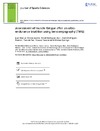Identificador persistente para citar o vincular este elemento:
https://accedacris.ulpgc.es/jspui/handle/10553/45287
| Título: | Assessment of muscle fatigue after an ultra-endurance triathlon using tensiomyography (TMG) | Autores/as: | García Manso, Juan Manuel Rodríguez-Ruiz, David Rodríguez-Matoso, Dario de Yves, Saa Sarmiento Montesdeoca, Samuel Quiroga Escudero, Miriam Esther |
Clasificación UNESCO: | 241106 Fisiología del ejercicio | Palabras clave: | Tensiomyography Ironman long-distance race neuromuscular fatigue mechanical characteristics of muscle |
Fecha de publicación: | 2011 | Editor/a: | 0264-0414 | Publicación seriada: | Journal of Sports Sciences | Resumen: | In this study, we used tensiomyography (TMG) to assess muscle status immediately after an ultra-endurance triathlon. Maximal radial displacement or deformation of the muscle belly, contraction time, delay time, sustain time, and relaxation time were measured for both legs, and dependent t-tests were used to compare means between the beginning and end of the race. The 19 men assessed (age 37.9 ± 7.1 years; height 177.5 ± 4.6 cm; weight: 73.6 ± 6.5 kg) participated in the 2009 edition of the Lanzarote Ironman. Deterioration in the neural response was observed for contraction time (P = 0.008) and relaxation time (P = 0.011), with a moderate decrease in the response time (sustain time) and a loss in muscle stiffness (deformation of the muscle belly). The effect of muscle fatigue on the rectus femoris and biceps femoris was different. Barely any changes in contraction time, relaxation time, sustain time, and deformation of the muscle belly were observed, while only the contraction response time decreased to a significant extent (reduction in delay time; P = 0.003). The considerable loss in contractile capacity induced by a long-distance race was reflected in changes in the neuromuscular response and fluctuations in the contractile capacity of the muscle. These modifications, derived from a prolonged, exhausting effort, can be assessed in a simple, non-aggressive, non-invasive way using tensiomyography. | URI: | https://accedacris.ulpgc.es/handle/10553/45287 | ISSN: | 0264-0414 | DOI: | 10.1080/02640414.2010.548822 | Fuente: | Journal of Sports Sciences[ISSN 0264-0414],v. 29, p. 619-625 |
| Colección: | Artículos |
Citas SCOPUSTM
129
actualizado el 08-jun-2025
Citas de WEB OF SCIENCETM
Citations
125
actualizado el 08-jun-2025
Visitas
119
actualizado el 09-mar-2024
Descargas
581
actualizado el 09-mar-2024
Google ScholarTM
Verifica
Altmetric
Comparte
Exporta metadatos
Los elementos en ULPGC accedaCRIS están protegidos por derechos de autor con todos los derechos reservados, a menos que se indique lo contrario.
